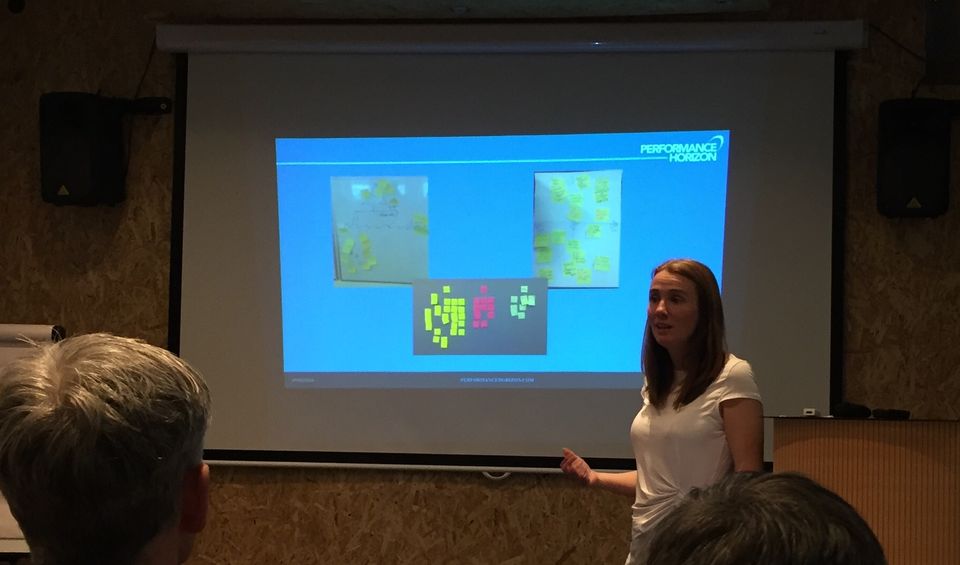Scrum Master, UX Designer: Common Ground?

Last night I made it to my first Agile North East meetup. As a UXer, I wish I’d been there months before.
The group has been going just under a year two years. I’ve been aware of it since its inception, but never made it a priority to attend (for various reasons). However, the tipping point was when organiser and HMRC Scrum Master Jon McNestrie did a great Agile workshop at Orange Bus on communicating requirements. Using LEGO.
Good fun playing Lego Requirements Game with @orangebus at their weekly Beers for Ideas #agile pic.twitter.com/ehODoGOlEp
— Jon McNestrie (@JonMcNestrie) February 5, 2016
So, I made my way to the fabulous Campus North space to hear Ania Maxwell and Phillip Steele talk about retrospectives and Agile culture respectively.
As someone from a design background, I don’t have a huge knowledge of the practice of learning Agile. And while the audience similarly had mixed knowledge of things such as retrospectives, I suspect I was the only UX person in the room. However, I started to see a lot of overlap between the two communities of practice of agile and UX (OK, UX/design thinking/service design, but let me bend the analogy just a little).
Permission to play?
Ania Maxwell’s retrospective on retrospectives (the most meta talk I’d been to since Darci Dutcher’s workshop on workshops at UX Scotland) emphasised the need to create a safe space for honest and actionable discussion. This usually has a process of what we did well/what we didn’t/how we can improve—but it can be done a lot more creatively than just having post-its on a chart. She gave examples of using visual means to gauge opinion, from ships with anchors holding people back to what put wind in their sails, to a start/stop/continue train.

As it turns out, there’s a whole website and a book of similar retrospective related activities. (Thanks Anil!)
This reminded me of the similar design work my friend Emma Jefferies is doing based on ‘permission to play’ and the book for designers Gamestorming. Play is actually a means of helping people feel that they’re in a safe space in which they can be honest—play is all about creating a ‘magic circle’ with a few rules that otherwise allow for anything goes.
Leadership: Scrum Masters and Participatory Design
Phillip Steele’s discussion on leadership as a scrum master emphasised allowing innovation and creativity in a team and being a facilitator rather than a manager (and in some situations, potentially having to be a blocker and educator to other upper level people who don’t really understand Agile).
Discussing trust ownership model https://t.co/tUxQcAPp84 @agile_ne pic.twitter.com/wmFY4GndGW
— Vicky Teinaki (@vickytnz) February 9, 2016
Encouraging creativity and innovation sounds very much like design leadership or participatory design, particularly as the conversation steered into faciliatation and giving control over to a team so that it would pass the ‘vacation test’ (that the scrum master can go on holiday and the systems not get abandoned). One of the aims of co-creation in design is meaning that it is eventually taken over by the participants rather than being ‘given’ to them from the designer.
There was also a heated discussion on how to allow team members to make decisions on options: should you tell someone you think their idea is problematic or just ask questions and try and get them to come to that decision themselves? For those of us in design, the answer is the practice of the design crit (critique) where constructive feedback is encouraged… even if it can sometimes be damning. (For the record, the best discussion of this is from Dan Saffer’s Everything I’ve Ever Learned About Design Critique I Learned From Tim Gunn. Yes. The Project Runway Tim Gunn).
Interestingly, I’m currently reading a lot about design leadership: my current Kindle read is Articulating Design Decisions by Tom Greever. Some of the tips discussed there sound similar to those in The Agile Culture and The Five Dysfunctions of a Team as recommended during the talk.

Avoiding Cargo Cults of both Agile and UX
Another recurring comment was ‘cargo cult’ Agile in which people go through the phases but don’t actually understand it. This type of thing is painfully similar to UX practitioners struggling against a perception that ‘user research belongs to everyone’ means that anyone can do it, best practice and experience be damned.
I’d argue that both disciplines suffer from seeming both magical and a lot easier than they appear (I guess that’s actually the definition of magic anyhow), and similarly a lack of awareness about what makes an example of ‘good’ Agile or UX.
We’re all doing great things
While I don’t know anywhere near as much about Agile as I do about UX and design, I’m excited to see how these overlap (and not just in the Lean UX way, as useful and important as that is). The focus on teams and empowerment (specifically trust and vulnerability) that I heard about at Agile North East is heartening, and I’d argue perhaps even more impressive than some design equivalents since it attempts to do it in what is arguably a pretty harsh environment – a tech heavy one with an emphasis on ongoing delivery.
I’m curious as to stories of this: beyond just being doing UX in Agile, how are the comparisons being made to do with design thinking and agile practices?
For more on Agile North East, check out the Meetup group. (They’re looking for lightning speakers in April and there will be prizes!)
Member discussion